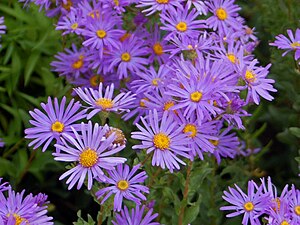Aster amellus: Difference between revisions
Μιμοῦ τὰ σεμνά, μὴ κακῶν μιμοῦ τρόπους → Graves imitatormores, ne imitator malos → Das Edle nimm zum Vorbild, nicht der Schlechten Art
(latin463) |
mNo edit summary |
||
| Line 2: | Line 2: | ||
|lgtx=[[ἀργεμώνιον]], [[ἀστέριον]], [[ἀστήρ]], [[ἀστερίσκος]], [[βουβώνιον]] | |lgtx=[[ἀργεμώνιον]], [[ἀστέριον]], [[ἀστήρ]], [[ἀστερίσκος]], [[βουβώνιον]] | ||
}} | }} | ||
==Wikipedia EN== | |||
[[File:Asteraceae - Aster amellus.JPG|thumb|Asteraceae - Aster amellus|alt=Asteraceae - Aster amellus.JPG]] | |||
Aster amellus, the European Michaelmas daisy, is a perennial herbaceous plant in the genus Aster of the family Asteraceae. | |||
The specific name amellus is first used in the Georgics (Book IV, 271-280), a poem of the Latin poet Publius Vergilius Maro (70 BC - 19 BC), but the etymology is obscure and uncertain. | |||
The English common name derives from the flowers being in bloom during Michaelmas (the Feast of St. Michael the archangel) | |||
Also called: Amellus officinalis Gaterau; Amellus vulgaris Opiz; Aster acmellus Pall.; Aster albus Willd. ex Spreng.; Aster amelloides Hoffm.; Aster amellus subsp. bessarabicus Soó; Aster atticus Pall.; Aster bessarabicus Bernh. ex Rchb.; Aster collinus Salisb.; Aster elegans Nees; Aster noeanus Sch.Bip. ex Nyman; Aster ottomanum Velen.; Aster pseudoamellus DC.; Aster purpureus Gueldenst. ex Ledeb.; Aster scepusiensis Kit. ex Kanitz; Aster tinctorius Wallr.; Aster trinervius Gilib.; Diplopappus asperrimus DC.; Diplopappus laxus Benth.; Galatella asperrima Nees; Kalimares amellus Raf. ex B.D.Jacks. | |||
Revision as of 09:18, 25 August 2022
Latin > Greek
ἀργεμώνιον, ἀστέριον, ἀστήρ, ἀστερίσκος, βουβώνιον
Wikipedia EN
Aster amellus, the European Michaelmas daisy, is a perennial herbaceous plant in the genus Aster of the family Asteraceae.
The specific name amellus is first used in the Georgics (Book IV, 271-280), a poem of the Latin poet Publius Vergilius Maro (70 BC - 19 BC), but the etymology is obscure and uncertain.
The English common name derives from the flowers being in bloom during Michaelmas (the Feast of St. Michael the archangel)
Also called: Amellus officinalis Gaterau; Amellus vulgaris Opiz; Aster acmellus Pall.; Aster albus Willd. ex Spreng.; Aster amelloides Hoffm.; Aster amellus subsp. bessarabicus Soó; Aster atticus Pall.; Aster bessarabicus Bernh. ex Rchb.; Aster collinus Salisb.; Aster elegans Nees; Aster noeanus Sch.Bip. ex Nyman; Aster ottomanum Velen.; Aster pseudoamellus DC.; Aster purpureus Gueldenst. ex Ledeb.; Aster scepusiensis Kit. ex Kanitz; Aster tinctorius Wallr.; Aster trinervius Gilib.; Diplopappus asperrimus DC.; Diplopappus laxus Benth.; Galatella asperrima Nees; Kalimares amellus Raf. ex B.D.Jacks.

